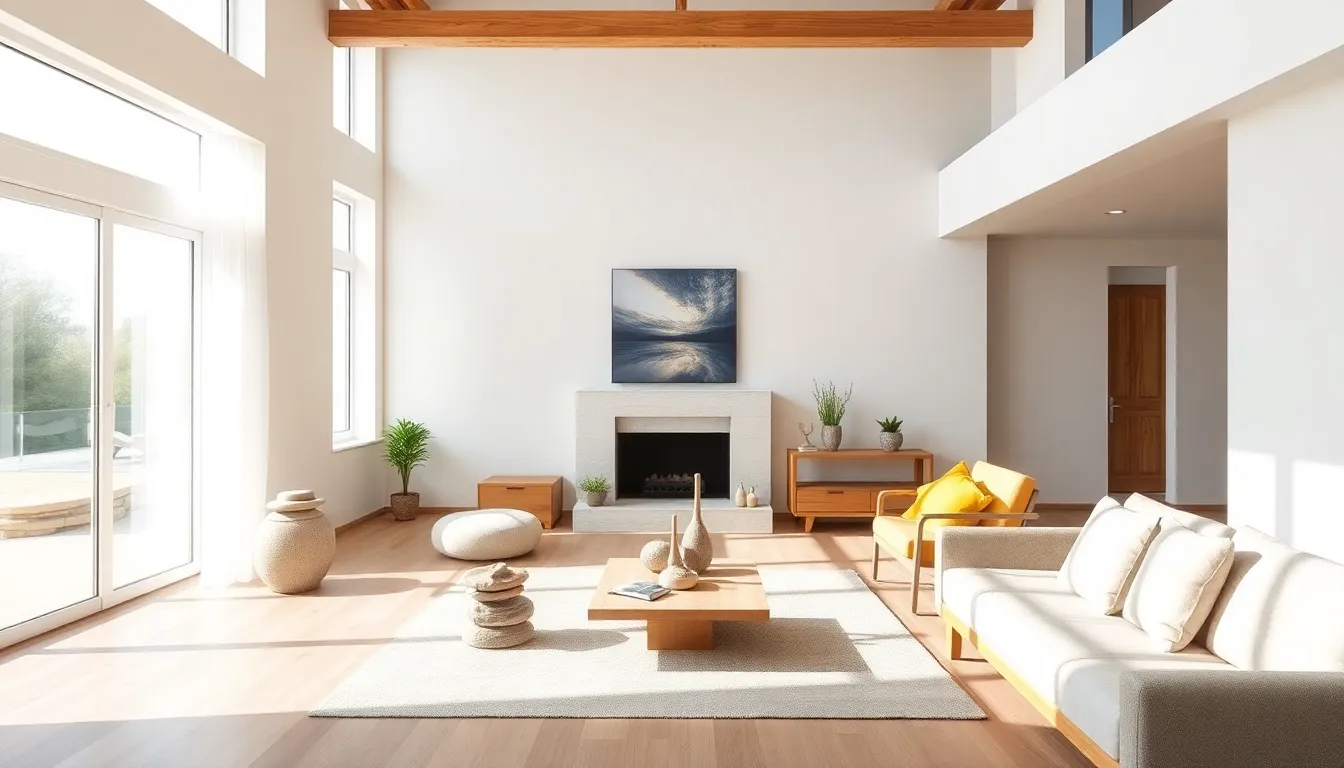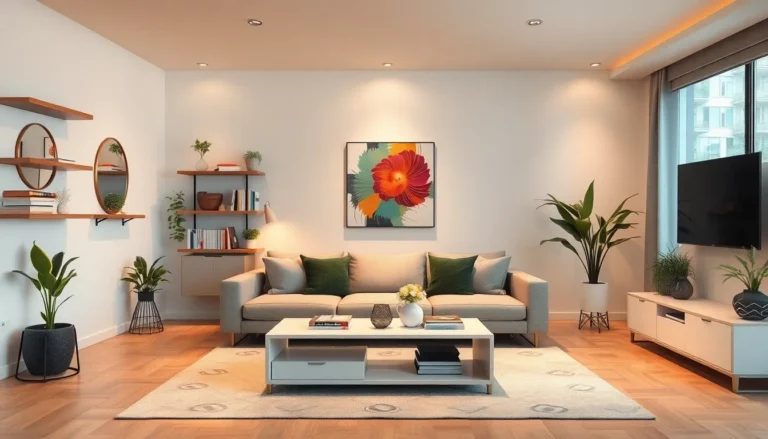In a world where home is no longer just a place but a canvas for self-expression, modern interior design ideas have taken center stage. Gone are the days of cookie-cutter decor; now it’s all about creating spaces that reflect individuality and style. Whether it’s a cozy nook for reading or a vibrant living room that screams personality, the possibilities are endless.
Table of Contents
ToggleOverview of Modern Home Interior Design
Modern home interior design focuses on simplicity, functionality, and an open-concept approach. This aesthetic emphasizes clean lines, neutral color palettes, and minimalist furnishings. Organic materials like wood and stone often dominate, promoting a connection to nature.
Spaces prioritize comfort and versatility, allowing for seamless transitions between areas. Natural light plays a crucial role, with large windows and strategic placement fostering warmth and energy. Each room serves a distinct purpose, yet they harmonize through cohesive design elements.
Art and decor reflect personal style, moving away from traditional decor to curated collections. Wall art and sculptures often serve as focal points, introducing character. Soft textures, such as rugs and cushions, enhance comfort while adding layers.
Innovative storage solutions contribute to the minimalist ethos, maximizing utility without sacrificing aesthetics. Built-in shelves, hidden cabinets, and multifunctional furniture keep spaces uncluttered. Technology integrates into design, facilitating smart home features that enhance convenience.
Color trends showcase bold accents against a backdrop of neutral tones. Statement pieces, like a bright sofa or decorative accessories, catch the eye in thoughtfully designed spaces. Patterns and textures bring depth, enriching the overall visual experience.
Sustainable practices also influence modern design. Many homeowners now favor eco-friendly materials and energy-efficient solutions, reflecting a commitment to the environment. Overall, modern interior design captures the essence of individual expression while remaining functional and inviting.
Key Elements of Modern Design

Modern interior design integrates several key elements that enhance functionality and aesthetics. These elements foster a harmonious environment where individuals can express their unique styles.
Color Schemes
Neutral color palettes dominate modern design. Shades of white, gray, and beige create a calming backdrop for spaces. Bold accent colors inject personality into rooms, with deep blues or vibrant yellows often chosen for emphasis. Additionally, pairing muted hues with bright tones maintains balance while allowing individuality to shine. This approach ensures that color enhances rather than overwhelms the space.
Materials and Textures
Natural materials play a significant role in contemporary interiors. Wood, stone, and metal create visual interest and tactile experiences. Textures introduce depth, with soft fabrics like linen and cotton contrasting against sleek surfaces. The combination of different textures adds warmth and richness to spaces. Furniture often features clean lines and simple forms, emphasizing an uncluttered aesthetic. Incorporating organic elements strengthens the connection to nature, promoting a serene atmosphere throughout the home.
Popular Modern Interior Design Styles
Modern interior design features diverse styles, each offering unique elements and atmospheres. Understanding these popular styles helps in creating personalized spaces.
Minimalism
Minimalism focuses on simplicity and essential elements. Clean lines and uncluttered spaces define this style, promoting a sense of calm. Neutral color palettes serve as the backdrop, with occasional bold accent colors to add interest. Furniture pieces often feature functional designs, enhancing practicality without compromising aesthetics. Natural light plays a crucial role, with large windows inviting warmth into the space. Decorative items are limited to curated collections, enhancing the overall minimalist ethos.
Industrial Design
Industrial design celebrates raw, unfinished elements. Exposed brick walls and metal fixtures create an urban feel, offering a blend of vintage and contemporary aesthetics. Open spaces and high ceilings enhance the expansive ambiance, perfect for showcasing unique furniture selections. Color tones commonly include grays and browns, emphasizing a muted yet stylish atmosphere. Incorporating reclaimed materials often serves as a sustainable choice, further enhancing the industrial vibe.
Scandinavian Influence
Scandinavian influence prioritizes functionality and coziness. Light color schemes and natural wood accentuate a sense of warmth and simplicity. Soft textiles such as wool and cotton enhance comfort, making spaces inviting. Practical furniture designs often feature multipurpose functionality, reflecting the need for versatility. Additionally, this style embraces minimal clutter while highlighting beautiful decor pieces. Indoor plants frequently add liveliness, connecting interiors to nature and creating a soothing environment.
Modern Home Interior Design Ideas
Modern home interior design emphasizes personalization and functionality, creating spaces that reflect individual style. Trends highlight comfort while promoting a harmonious flow throughout the home.
Open Concept Living
Open concept living fosters a sense of space and connection. Walls often come down, creating a seamless transition between the kitchen, dining, and living areas. This layout encourages social interaction, perfect for families and entertaining guests. Natural light floods the space, enhancing warmth and energy. Such designs frequently incorporate large islands in kitchens, allowing for additional seating and workspace. Flexibility remains key, as furniture arrangements can adapt to various activities.
Multi-Functional Spaces
Multi-functional spaces accommodate diverse needs within the home. Rooms often serve multiple purposes, such as a guest room that doubles as a home office. Creative furniture solutions, like sofa beds and foldable tables, maximize utility without compromising style. Incorporating built-in storage helps maintain organization, keeping spaces tidy and inviting. With technology becoming more integrated, many rooms now feature smart devices that enhance functionality. This approach leverages every square foot while maintaining a sense of openness and flow.
Statement Furniture and Decor
Statement furniture and decor elevate modern interiors, transforming them into curated spaces. Unique pieces, such as oversized art installations or striking furniture, serve as focal points that showcase personal taste. Mixing textures, like leather with soft fabrics, adds depth while enhancing visual interest. Many homeowners incorporate eco-friendly materials, aligning aesthetics with sustainability. Vibrant accents against neutral backgrounds create a dynamic atmosphere, highlighting individual expression. Lighting fixtures also make bold statements, serving both aesthetic and functional roles in the design.
Modern home interior design embodies the essence of individuality and functionality. By embracing personalized spaces homeowners can create environments that resonate with their unique tastes while ensuring comfort and practicality. The emphasis on open-concept layouts and natural materials enhances the flow of light and energy throughout the home.
Incorporating bold accents and statement pieces adds character to otherwise neutral palettes. This approach not only elevates aesthetics but also reflects a commitment to sustainability. As design continues to evolve homeowners are empowered to transform their living spaces into true reflections of themselves.








